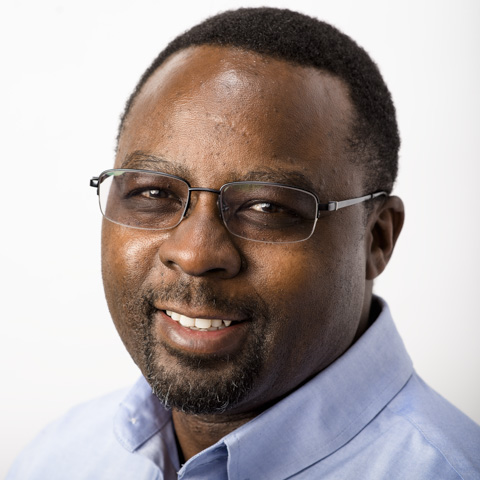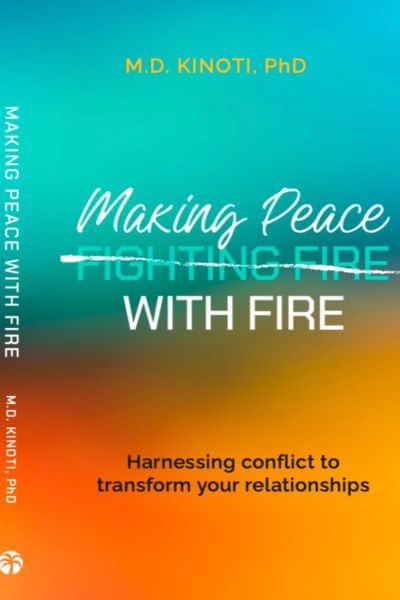Q and A with M.D. Kinoti about his book, Making Peace with Fire
Professor M.D. Kinoti, Ph.D., recently released Making Peace with Fire: Harnessing Conflict to Transform your Relationships, which explores ways to navigate conflict peacefully. He spoke about his recent work in a Q&A.
Q: How did you decide you wanted to write a book about this?
A: I wrote "Making Peace with Fire: Harnessing Conflict to Transform your Relationships, driven by a desire to heal the deep-seated strife I saw tearing apart my own family and community. The dysfunctional dynamics in my family, alongside constant conflicts between neighbors, clans, and tribes, fueled a cycle of pain. This wasn't unique to my personal experience. Over the last 25 years working in an international nongovernmental organization as a mediator and now in teaching, I have witnessed these same destructive power struggles playing out across communities. The book is my attempt to offer hope and guidance for breaking free from this cycle. It is also a challenge to me and all to do more for a peaceful living, individually and in the community.
Q: You shared many stories about your childhood experiences and found a way to weave those into this book. Can you talk about what those experiences taught you?
A: Pouring my experiences into Making Peace with Fire was a powerful healing journey. Growing up, my family was a microcosm of the larger conflicts that raged around me. The dysfunction at home, the constant tension with neighbors, the way feuds seemed to simmer between clans and tribes for generations – it all left a deep mark. It was confusing and isolating, and frankly, it hurt. Then, there were the workplaces where I was blessed to serve. In each of these, I have witnessed various levels of conflict, some minor and passed on quickly, but others that left deep wounds on the people and the organizations. Not to mention the immense amounts of time I have witnessed spent on dealing with conflicts. It was like looking into a mirror – the same destructive patterns writ large.
But those experiences also became my teachers. Seeing firsthand how unresolved conflict could poison relationships, fracture communities, and leave everyone feeling burnt sparked a deep desire to understand the root causes. Later, studying peacebuilding and working as a mediator, and now teaching courses in peace and development, I saw the power of intentional efforts for understanding and growth.
So, my life experiences, though sometimes painful, have fueled my passion for finding solutions. They instilled in me the importance of open communication, empathy, and the power of forgiveness and other intentional peacebuilding efforts. "Making Peace with Fire" is my way of sharing those lessons, offering a roadmap for breaking free from destructive cycles and building relationships and a future of peace.
Q: You encourage readers to take those conflicts and turn those into opportunities – How does a person do that, and what suggestions do you have?
A: Transforming conflict from a roadblock to a bridge requires a shift in perspective. Instead of dreading disagreements, view them as opportunities to understand each other more deeply. When a conflict arises, focus on active listening. Try to see things from the other person's viewpoint and communicate your needs and feelings. I encourage us not to shy away from difficult conversations but to approach them with empathy and respect. By working together to find solutions that address everyone's concerns, you can transform the conflict and strengthen your bond. This collaborative approach to conflict fosters trust, builds communication skills, and ultimately leads to more fulfilling relationships.
Q: We’re in a very volatile time in history where much of our country is divided, and even conflicts around the world are dividing people. How do we return to a place where we’re not constantly fighting or working through this?
A: It is true that these are divisive times. Some of this is driven by ignorance, selfishness, and even greed. The good news is that the tools that mend relationships on a personal level can also bridge societal divides. We need to move beyond simply winning arguments and instead focus on building bridges of understanding. This means actively listening to those with different viewpoints, even when uncomfortable. By seeking common ground and fostering empathy, we can break down the walls of hostility. It won't be easy, but starting these conversations in our communities and encouraging civil discourse can pave the way for a more peaceful and unified future.
Q: What is your hope when people read this book?
A: My deepest hope is that Making Peace with Fire ignites a spark of transformation within readers. I want people to see the conflicts in their lives not as dead ends but as opportunities for growth and connection. By sharing my experiences and the tools I've learned, I aim to empower readers to break free from destructive cycles and build healthier, more fulfilling relationships. Imagine the ripple effect if everyone who reads this book embraced the power of understanding and forgiveness – our communities, our nations, and even the world itself could be transformed. That's the future I dream of, and "Making Peace with Fire" is my contribution to making it a reality.
"Making Peace with Fire" is also a desire to spark conversation in general. I hope more people can start talking and learning about how to transform relationships by utilizing their conflict situations. I write from who I am: an African, strongly influenced by faith in Jesus Christ, educated, and an immigrant to the United States. I know that the experiences and lessons I have drawn here are located in a place that may appeal to some rather than others and, therefore, is limited. Consequently, I want to encourage more people to write from their backgrounds and perspectives on how we can live at peace with one another. I believe sharing these stories from various perspectives will help us embrace and seek transformative ways to live with one another.
Q: Where can people purchase the book?
A: There are several outlets where you can purchase the book. Follow this link to see a synopsis of the book and the purchase outlets in the United States and abroad - Making Peace with Fire.

